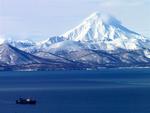 The Kamchatka Peninsula, one of the most easterly parts of Russia and all Asia, is an unforgettable land marked by contrasts: ice and fire, geyser-studded deserts and lush vegetation. From a geological standpoint it is a young region. And it is young as far as tourism is concerned, too. During the Soviet period the region was essentially a military zone, strictly off-limits for foreigners and even for Soviet citizens who did not live there. The military nature of the peninsula, however, dates back to the beginning of Russian dominion. Vladimir Atlassov, a Russian fur merchant who had come to Siberia in search of fortune and was then appointed general of the Cossacks, took possession of the peninsula in the name of Tsar Peter the Great. It was on 13 July 1697, as can be seen by the date engraved on the cross set in front of the first fort that Atlassov built on the banks of the Kamchatka river. The Kamchatka Peninsula, one of the most easterly parts of Russia and all Asia, is an unforgettable land marked by contrasts: ice and fire, geyser-studded deserts and lush vegetation. From a geological standpoint it is a young region. And it is young as far as tourism is concerned, too. During the Soviet period the region was essentially a military zone, strictly off-limits for foreigners and even for Soviet citizens who did not live there. The military nature of the peninsula, however, dates back to the beginning of Russian dominion. Vladimir Atlassov, a Russian fur merchant who had come to Siberia in search of fortune and was then appointed general of the Cossacks, took possession of the peninsula in the name of Tsar Peter the Great. It was on 13 July 1697, as can be seen by the date engraved on the cross set in front of the first fort that Atlassov built on the banks of the Kamchatka river.
The natives took Atlassov to see a Japanese who had ended up there after a shipwreck and who, because of his physical difference and the fact that he knew how to write, was considered a demigod. The Japanese sailor was presented to Peter the Great who, after listening to his accounts, decided to try to reach the fabulous Far East from the Kamchatka Peninsula. He charged Vitus Bering with the task of finding a route from Russia to Japan via the Arctic Sea. One century later Kamchatka was already a militarised zone and its chief town, Petropavlosk-Kamatchatskiy, had become one of the empire's leading naval bases. Only in very recent times have the frontiers that isolated Kamchatka from the rest of the world been removed, so that the mysterious peninsula could welcome its first visitors, revealing its many marvels - the 120 volcanoes, many of which are still active; the 200 geysers constantly spouting their jets of water; the majestic, cone-shaped, snow-clad mountains; the boundless glaciers; the immense forests, craters become enchanting lakes, rivers filled with salmon, and parks with wild animals.
The truly marvellous part of the peninsula is the Kronotskiy Wildlife Reserve, one of the largest of its kind in Russia (one million square hectares), which lies on the eastern coast of Kamchatka. It is dominated by the forbidding cone of the Kronotskaya Sopka volcano, which is covered with snow but often crowned with puffs of smoke; at the foot of this impressive mountain is Lake Kronotskiy, where thousands of salmon come to breed and to die. Here the earth is always boiling, as it were, emitting gas, as in the famous and spectacular valley of geysers that has 200 of the Earth's 800 geysers, with their gushing hot springs.
The extinct volcano craters have given rise to fantastic phenomena such as the Uzon caldera, a vast plain produced by the collapse of an ancient volcano, speckled with the many colours of the extraordinary vegetation, and the incredible hot Maliy Semliachik lake created in the crater of an old volcano, with its bright turquoise colour caused by the minerals in the water.
The Kronotskiy reserve is the home of rare animals such as brown bears, sables, wolves, lynxes, sea otters, Kamchatkan sea eagles, eagles and the very rare gerfalcon, which was used for hunting by medieval emperors. The reserve was established in 1938 at the request of the local hunters in order to protect endangered species. The main resou rces in Kamchatka are in fact furs (especially sable), fishing (mostly salmon), timber, which is got mostly from the large birch forests, and deer-breeding. rces in Kamchatka are in fact furs (especially sable), fishing (mostly salmon), timber, which is got mostly from the large birch forests, and deer-breeding.
The Kamchatka Peninsula is 1,200 km long and 450 km wide, with only half a million inhabitants. It has two mountain chains, the Eastern (Vostochny) and the Central (Sredin-ny). Between these two ranges, in the northern part of the peninsula, is the large volcanic pla-teau dominated by Mt. Kliuchevskaya Sopka (4,850 m), one of the tallest active volcanoes in the world. The most popular mountains for climbers are further to the south, not far from Petropavlovsk-Kamchatskiy: Avachinskaya Sopka (2,741 m) and Koriakskaya Sopka (3,456 m). Here in late spring skiing while being pulled by helicopters is common, and extremely interesting rock, ice and snow routes (rated from IB to 3A) have been opened; especially in the summer, ice axes, crampons, rope and pitons are needed. In May you can make the ascent on skis. The descent is beautiful.
|













 Pearls of Russia
Pearls of Russia  Golden resorts
Golden resorts